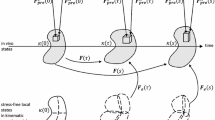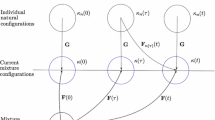Abstract
This paper outlines the framework of a porous flow mixture theory for the mathematical modelling of in vitro tissue growth, and gives an application of this theory to an aspect of tissue engineering. The problem is formulated as a set of partial differential equations governing the space and time dependence of the amounts of each component of the tissue (phase), together with the physical stresses in each component. The theory requires constitutive relations to specify the material properties of each phase, and also requires relations to specify the stresses developed due to mechanical interactions, both within each phase and between different phases. An application of the theory is given to the study of the mobility and aggregation of a population of cells seeded into an artificial polymeric scaffold. Stability analysis techniques show that the interplay of the forces between the tissue constituents results in two different regimes: either the cells form aggregates or disperse through the scaffold.
Similar content being viewed by others
References
Alt, W., Dembo, M.: Cytoplasm dynamics and cell motion: two-phase flow models. Math. Biosci. 156, 207–228 (1999)
Araujo, R.P., McElwain, D.L.S.: A mixture theory for the genesis of residual stresses in growing tissues I: A general formulation. SIAM J Appl. Math. 65, 1261–1284 (2005)
Atkin, R.J., Craine, R.E.: Continuum theories of mixtures: basic theory and historical development. Q. J. Mech. Appl. Math. 29, 209–244 (1976)
Barocas, V.H., Tranquillo, R.T.: An anisotropic biphasic theory of tissue-equivalent mechanics: the interplay among cell traction, fibrillar network deformation, fibril alignment, and cell contact guidance. J. Biomech. Eng. 119, 137–145 (1997)
Bhati, R.S., Mukherjee, D.P., McCarthy, K.J., Rogers, S.H., Smith, D.F., Shalaby, S.W.: The growth of chondrocytes into a fibronectin-coated biodegradable scaffold. J. Biomed. Mater. Res. 56 (1), 74–82 (2001)
Bowen, R.M.: Theory of mixtures. In: A. C. Eringen (ed.), Continuum physics, pp. 1–127 Academic Press, 1976
Bowen, R.M.: Incompressible porous media models by use of the theory of mixtures. Int. J. Engng Sci. 18, 1129–1148 (1980)
Breward, C.J.W., Byrne, H.M., Lewis, C.E.: The role of cell-cell interactions in a two-phase model for avascular tumour growth J. Math. Biol. 45, 125–152 (2002)
Byrne, H., Chaplain, M.A.J.: Free boundary value problems associated with the growth and development of multicellular spheroids. Eur. J. Appl. Math. 8 (6), 639–658 (1997)
Byrne, H., Preziosi, L.: Modelling solid tumour growth using the theory of mixtures. Math. Med. Biol. 20 (4), 341–366 (2003)
Byrne, H.M., King, J.R., McElwain, D.L.S., Preziosi, L.: A two-phase model of tumour growth. Appl. Math. Lett. 16, 567–573 (2003)
Cowin, S.C.: How is a tissue built? J. Biomech. Eng. 122, 553–569 (2000)
Cowin, S.C.: Tissue growth and remodeling. Annu. Rev. Biomed. Eng. 6, 77–107 (2004)
Dar, A., Shachar, M., Leor, J., Cohen, S.: Optimization of cardiac cell seeding and distribution in 3D porous alginate scaffolds. Biotechnol. Bioeng. 80, 305–312 (2002)
Dee, K.C., Andersen, T.T., Bizios, R.: Osteoblast population migration characteristics on substrates modified with immobilized adhesive peptides. Biomaterials 20, 221–227 (1999)
Dembo, M., Harlow, F.: Cell motion contractile networks and the physics of interpenetrating reactive flow. Biophys. J. 50, 109–121 (1986)
Drew, D.A.: Mathematical modeling of two-phase flow. Ann. Rev. Fluid Mech. 15, 261–291 (1983)
Drew, D.A., Passman, S.L.: Theory of multicomponent fluids. Springer, 1999
Drew, D.A., Segel, L.A.: Averaged equations for two-phase flows. Stud. Appl. Math. L 3, 205–231 (1971)
Ermentrout, G.B., Edelstein-Keshet, L.: Cellular automata approaches to biological modeling. J. Theor. Biol. 160, 97–133 (1993)
Forgacs, G., Foty, R.A., Shafrir, Y., Steinberg, M.S.: Viscoelastic properties of living embryonic tissues: a quantitative study. Biophys. J. 74, 2227–2234 (1998)
Foty, R.A., Forgacs, G., Pfleger, C.M., Steinberg, M.S.: Liquid properties of embryonic-tissues - measurement of interfacial-tensions. Phys. Rev. Lett. 72 (14), 2298–2301 (1994)
Galban, C.J., Locke, B.R.: Analysis of cell growth in a polymer scaffold using a moving boundary approach. Biotechnol. Bioeng. 56 (4), 422–432 (1997)
Garikipati, K., Arruda, E.M., Grosh K., Narayanan H., Calve, S.: A continuum treatment of growth in biological tissue: the coupling of mass transport and mechanics. J. Mech. Phys. Solids. 52, 1595–1625 (2004)
Grodzinsky, A.J., Kamm, R.D., Lauffenburger, D.A.: Quantitative aspects of tissue engineering: basic issues in kinetics transport and mechanics. In: R Lanzer and R Langer and W Chick (ed.), Principles of Tissue Engineering. pp. 193–207 R.G. Landes Company, 1997
Hoger, A.: Virtual configurations and constitutive equations for residually stressed bodies with material symmetry. J. Elast. 48 (2), 125–144 (1997)
Humphrey, J.D.: Continuum biomechanics of soft biological tissues. Proc. R. Soc. Lond. A 459, 3–46 (2003)
Humphrey, J.D., Rajagopal, K.R.: A constrained mixture model for growth and remodeling of soft tissues. Math. Mod. Meth. Appl. S. 12, 407–430 (2002)
Hunter, D.J., March, L., Sambrook, P.N.: Knee osteoarthritis: The influence of environmental factors. Clin. Exp. Rheumatol. 20 (1), 93–100 (2002)
Ingram, J.D., Eringen, A.C.: A continuum theory of chemically reacting media - II Constitutive equations of reacting fluid mixtures. Int. J. Engng Sci. 5, 289–322 (1967)
Ishuag-Riley, S.L., Crane-Kruger, G.M., Miller, M.J., Yasko, A.W., Yaszemski, M.J., Mikos, A.G.: Bone formation by three-dimensional stromal osteoblast culture in biodegradable polymer scaffolds. J. Biomed. Mater. Res. 36, 17–28 (1997)
Ishuag-Riley, S.L., Crane-Kruger, G.M., Yaszemski, M.J., Mikos, A.G.: Three-dimensional culture of rat calvarial osteoblasts in porous biodegradable polymers. Biomaterials 19, 1405–1412 (1998)
Itano, N., Atsumi, F., Sawai, T., Yamada, Y., Miyaishi, O., Senga, T., Hamaguchi, M., Kimata, K.: Abnormal accumulation of hyaluronan matrix diminishes contact inhibition of cell growth and promotes cell migration. P. Natl. Acad. Sci. USA 99 (6), 3609–3614 (2002)
Jakab, K., Neagu, A., Mironov, V., Markwald, R.R., Forgacs, G.: Engineering biological structures of prescribed shape using self-assembling multicellular systems. P. Natl. Acad. Sci. USA. 101 (9), 2864–2869 (2004)
Lai, W.M., Hou, J.S., Mow, V.C.: A triphasic theory for the swelling and deformational behaviours of articular cartilage. J. Biomech. Eng. 113, 245–258 (1991)
Landman, K.A., Please, C.P.: Tumour dynamics and necrosis: surface tension and stability. Math. Med. Biol. 18, 131–158 (2001)
Langer, R., Vacanti, J.P.: Tissue Engineering. Science 260, 920–926 (1993)
Lappa, M.: Organic tissues in rotating bioreactors: fluid-mechanical aspects dynamic growth models, and morphological evolution. Biotechnol. Bioeng. 84 (5), 518–532 (2003)
Levenberg, S., Langer, R.: Advances in tissue engineering. In: Current topics in developmental biology, Elsevier 61, (2004)
Li, S.H., de Wijn, J.R., Layrolle, P., de Groot, K.: Macroporous biphasic calcium phosphate scaffold with high permeability/porosity ratio. Tissue Eng. 9 (3), 535–548 (2003)
Longo, D., Peirce, S.A., Skalak, T.C., Davidson, L., Marsden, M., Dzamba, B., DeSimone, D.W.: Multicellular computer simulation of morphogenesis: blastocoel roof thinning and matrix assembly in Xenopus laevis. Dev. Biol. 271 (1), 210–222 (2004)
Lubkin, S.R., Jackson, T.: Multiphase mechanics of capsule formation in tumors. J. Biomech. Eng. 124 (2), 237–243 (2002)
MacArthur, B.D., Please, C.P., Taylor, M., Oreffo, R.O.C.: Mathematical modelling of skeletal repair. Biochem. Bioph. Res. Co. 313, 825–833 (2004)
Mackie, E.J.: Osteoblasts: novel roles in orchestration of skeletal architecture. Int. J. Biochem. Cell. B. 35 (9), 1301–1305 (2003)
Marle, C.M.: On macroscopic equations governing multiphase flow with diffusion and chemical reactions in porous media. Int. J. Engng Sci. 20 (5), 643–662 (1982)
Martin, I., Wendt, D., Heberer, M.: The role of bioreactors in tissue engineering. Trends Biotechnol. 22, 80–86 (2004)
Massoudi, M.: Constitutive relations for the interaction force in multicomponent particulate flows. Int. J. Nonlinear. Mech. 38 (3), 313–336 (2003)
Mizuno, S., Alleman, F., Glowacki, J.: Effects of medium perfusion on matrix production by bovine chondrocytes in three-dimensional collagen sponges. J. Biomed. Mater. Res. 56 (3), 368–375 (2001)
Morse, P.M., Feshbach, H.: Methods of theoretical physics. Vol 1. McGraw-Hill, 1953
Mow, V.C., Kuei, S.C., Lai, W.M., Armstrong, C.G.: Biphasic creep and stress relaxation of articular cartilage in compression: theory and experiment. J. Biomech. Eng. 102, 73–84 (1980)
Murray, J.D.: Mathematical Biology. Springer, 3rd edn. 2002
Palferman, T.G.: Bone and joint diseases around the world. The UK perspective. J. Rheumatol. 30, 33–35 (2003)
Rose, F.R., Cyster, L.A., Grant, D.M., Scotchford, C.A., Howdle, S.M., Shakesheff, K.M.: In vitro assessment of cell penetration into porous hydroxyapatite scaffolds with a central aligned channel. Biomaterials 25 (24), 5507–5514 (2004)
Roy, T.D., Simon, J.L., Ricci, J.L., Rekow, E.D., Thompson, V.P., Parsons, J.R.: Performance of degradable composite bone repair products made via three-dimensional fabrication techniques. J. Biomed. Mater. Res. A 66, 283–291 (2003)
Ryan, P.L., Foty, R.A., Kohn, J., Steinberg, M.S.: Tissue spreading on implantable substrates is a competitive outcome of cell-cell vs. cell-substratum adhesivity. P. Natl. Acad. Sci. USA. 98 (8), 4323–4327 (2001)
Saini, S., Wick, T.M.: Concentric cylinder bioreactor for production of tissue engineered cartilage: Effect of seeding density and hydrodynamic loading on construct development. Biotechnol. Prog. 19 (2), 510–521 (2003)
Sengers, B.G., Oomens, C.W.J., Baaijens, F.P.T.: An integrated finite-element approach to mechanics transport and biosynthesis in tissue engineering. J. Biomech. Eng. 126, 82–90 (2004)
Sharma, B., Elisseeff, J.H.: Engineering structurally organized cartilage and bone tissues. Ann. Biomed. Eng. 32 (1), 148–159 (2004)
Sheffield, R.E., Metzner, A.B.: Flows of nonlinear fluids through porous media. AIChE J. 22 (4), 736–744 (1976)
Sherwood, J.K., Riley, S.L., Palazzolo, R., Brown, S.C., Monkhouse, D.C., Coates, M., Griffith, L.G., Landeen, L.K., Ratcliffe, A.: A three-dimensional osteochondral composite scaffold for articular cartilage repair. Biomaterials 23, 4739–4751 (2002)
Sittinger, M., Perka, C., Schultz, O., Haupl, T., Burmester, G.R.: Joint cartilage regeneration by tissue engineering. Z. Rheumatol. 58 (3), 130–135 (1999)
Skalak, R., Zargaryan. S., Jain, R.K., Netti, P.A., Hoger, A.: Compatibility and the genesis of residual stress by volumetric growth. J. Math. Biol. 34 (8), 889–914 (1996)
Stock, U.A., Vacanti, J.P.: Tissue engineering: current state and prospects. Annu. Rev. Med. 52, 443–451 (2001)
Sun, D.N., Gu, W.Y., Guo, X.E., Lai, W.M., Mow, V.C.: A mixed finite element formulation of triphasic mechano-electrochemical theory for charged hydrated biological soft tissues. Int. J. Numer. Meth. Eng. 45, 1375–1402 (1999)
Truesdell, C., Noll, W.: The nonlinear field theory of mechanics. In: S. Flugge (ed.), Handbuch der Physik, Springer, 1960
Author information
Authors and Affiliations
Corresponding author
Rights and permissions
About this article
Cite this article
Lemon, G., King, J., Byrne, H. et al. Mathematical modelling of engineered tissue growth using a multiphase porous flow mixture theory. J. Math. Biol. 52, 571–594 (2006). https://doi.org/10.1007/s00285-005-0363-1
Received:
Revised:
Published:
Issue Date:
DOI: https://doi.org/10.1007/s00285-005-0363-1




